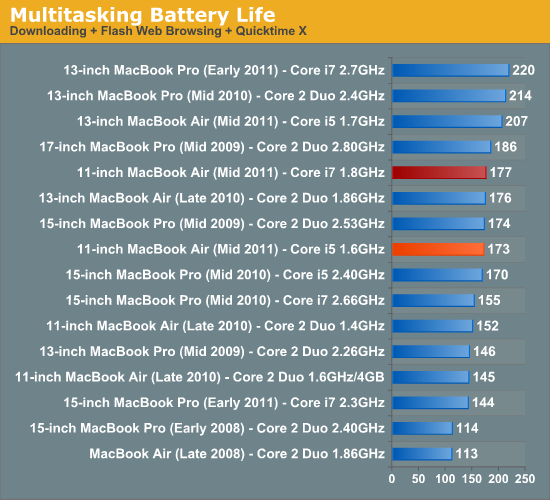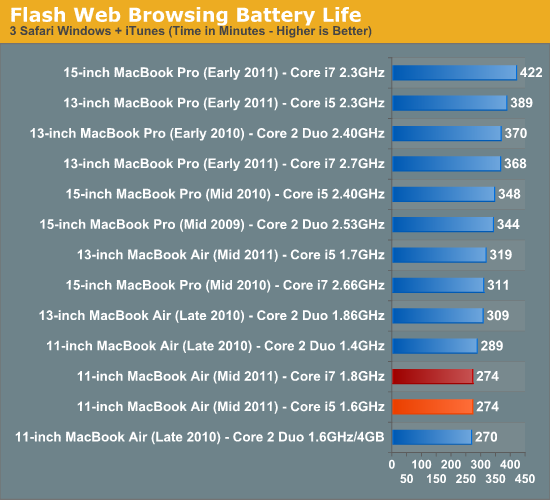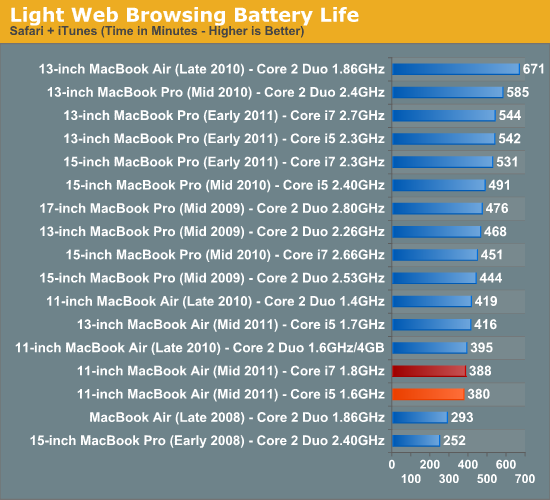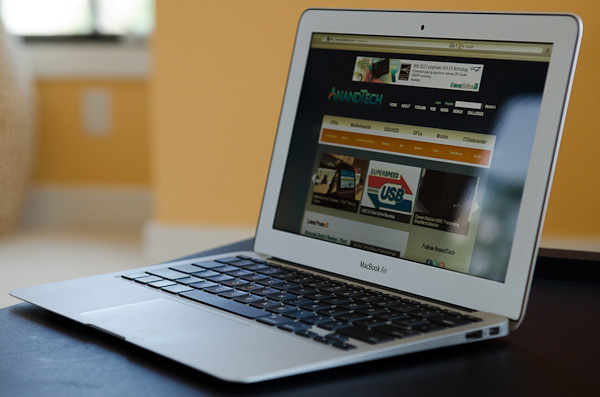Apple's 11-inch MacBook Air (Core i7 1.8GHz) Review Update
by Anand Lal Shimpi on August 1, 2011 6:08 PM EST- Posted in
- Mac
- Apple
- Intel
- Core i7
- Sandy Bridge
- MacBook Air
Battery Life
The 1.8GHz Core i7 doesn't run much faster by default than the 1.6GHz Core i5, but it can turbo up to a 25% higher clock speed than the Core i5. What's the impact on battery life?
If you're running a high CPU workload that never lets up in a continuous loop, the i7 is going to die quicker than the i5. Active power is greater at higher frequencies (assuming everything else remains the same) and with no chance to get to sleep the i7 will eat through the 35Wh battery faster than the i5.
Where the i7 stands a chance however is in workloads where you aren't running the CPU at full tilt all of the time. The i7 needs tiny, tiny, tiny fractions of a second of idle time to throttle down and go to sleep. It's in these sleep states that it'll draw very little power and avoid being a major consumer of that 35Wh (or 50Wh in the 13) battery. From the CPU's perspective, it wants to finish its work as quickly as possible so it can get back into its really low power idle states.
For workloads with balanced periods of load and idle time, the i7 should be able to at least equal the battery life of the i5. Short bursts of instructions can execute up to 25% faster on the i7, allowing it to go back to sleep that much quicker. Any energy expended from running at higher clock could be saved by spending more time at idle.
The other advantage is the larger L3 cache. A larger cache means a higher likelihood of finding data in that cache, which saves trips to main memory. Anytime you go off-chip for data the power penalty is tremendous. You have to fire up a powerful memory interface, drive requests back and forth over a high speed bus and actually pull the data from DRAM. The entire process is far more power intensive than just grabbing data from the CPU's on-die L3 cache. I wouldn't expect huge power savings from the L3 cache, but it's likely a net positive.
Our battery life tests are designed to run the gamut. Showing you the absolute best case use-your-notebook-as-a-typewriter light web browsing test to the get-stuff-done multitasking workload. I'd say most power users will see battery life similar to the worst case scenario, while mainstream users will be between that and the flash web browsing test. The writers in the crowd can shoot for the battery life in our lightest scenario if you really just spend your time in TextEdit.
All of our tests were run with dynamic brightness control disabled (panel brightness near 50% - we tried to equalize brightness across all systems) and the Macs were set to never go to sleep.
As you can see by the numbers below, there's basically no impact on battery life from the i7 upgrade. Note that none of these workloads keep the CPU pegged at 100% throughout the test. As I mentioned earlier, if you're going to be doing a long 3D render or compiling a very large project (multiple hours) you can expect worse battery life from the i7. Typical notebook usage models however shouldn't see much of a difference at all.
Multitasking Battery Life
In this test we have three open Safari windows, each browsing a set of web pages with between 1—4 flash ads per page, at the same time. We're also playing an XviD video in a window all while downloading files from a server at 500KB/s.

Flash Web Browsing
The test here has three Safari windows open, each browsing a set of web pages with between 1—4 animated flash ads per page, at the same time. Each page forwards onto the next after about 20 seconds.

Light Web Browsing
Here we're simply listening to MP3s in iTunes on repeat while browsing through a series of webpages with no flash on them. Each page forwards on to the next in the series after 20 seconds.












55 Comments
View All Comments
Ratman6161 - Tuesday, August 2, 2011 - link
Anand, you say "peaked at 36.2W it quickly dropped back down to and remained at 31 - 33.5W throughout the majority of the render."Have you considered that the reason that the power peaks and then drops off is that the CPU hits its thermal limits and starts throttling? That would explain when the power usage drops back down.
I recently got in a new Dell 6420 which uses a mobile i5 Sandy Bridge CPU (don't remember which model). When I run Intel Burn Test on it while also monitoring it with CPUZ and Hardware monitor, you can see this happening. When the burn test starts, you see the cpu speed scale up. Then the temperatures start to climb and you can hear the fans running faster. About the time the CPU goes over 80C, you see the multiplier drop, resulting in a lower clock speed. As it cools a little the clock speed comes back up a little and fluctuates with temperatures but never again hits the peak it reached when the test initially started.
As I understand things, this is exactly how you would expect a Sandy Bridge CPU to operate, particularly in the confined spaces of a laptop and even more so in an ultra portable. Seems to me if its throttling though the i5 is probably doing this too.
marraco - Wednesday, August 3, 2011 - link
You can't work:http://homepage.mac.com/davehagan/glossy10.jpg
You can't work:
http://www.blogcdn.com/www.tuaw.com/media/2008/10/...
You can't work:
http://3.asset.soup.io/asset/1813/7075_ee11_500.jp...
YOU CAN'T SEE ANYTHING!
http://9.asset.soup.io/asset/1803/6089_5cab_500.jp...
http://images.anandtech.com/reviews/mac/MacBookPro...
Why all the babble about color gamut??? Is a portable computer. You can't carry it to the park, because, you can't see the screen!
You can't use it on your house, because you need to close all the windows, you need to switch off all the lights, and then you can't read your papers.
YOU NEED TO MOVE ALL YOUR FURNITURE JUST TO USE A MAC.
You can't move to other place on the table, because a reflection kills you.
You can't work with the windows behind you because of the reflections. You can't use the window behind the computer because of the light contrast (you need to put down all the internal lights).
neoplasm - Wednesday, August 3, 2011 - link
Checkmate!KPOM - Wednesday, August 3, 2011 - link
The MacBook Air does not have a glass cover on top of the anti-glare coating. it is nowhere near as reflective as the MacBook Pro. I have no issues using it at home during the day or at night, and I get a lot of natural light in my apartment. I also don't have an issue using it on planes or in sunny airport lobbies. It's pretty easy to move the screen around so that light isn't shining directly on it.snakeInTheGrass - Monday, August 22, 2011 - link
I'm trying to see myself in my MacBook Air 11" screen right now. I have a window to the right of my desk, another behind me, and unless I align the screen to directly reflect the window I can't see any effect from it. Nice photos anyway, but I don't really think they're very representative of the Air screen.cantus - Saturday, August 6, 2011 - link
in such detailed reviews of the macbook airs as found on anandtech it is surprising if not even puzzling to not find a single word on fan noise in these highly compacted machines.
for many users sound levels are a key issue as the growing silent computing market shows and a clear evaluation of the sound levels of these machines is essential topic for any serious review to comment on. that anandtech, while providing the probably most in-depth reviews of the mac book airs does not do so is strange to say the least.
OrcaNZ - Sunday, August 7, 2011 - link
Thanks for a very informative review - I have the 11" i7 - and use it for work and casual gaming (CiV V etc). Great machine and honesty the best ultra portable laptop I have ever owned. Coming from a 2010 13" Macbook Pro, I found the weight saving of lugging it around everyday the biggest benefit. Best Apple product I have used to date.h00ligan76 - Tuesday, August 9, 2011 - link
You know, I love the anandtech reviews.. let's start with that.However the inconsistencies in testing make it difficult for one to evaluate for purchase - whether they be comparing the technology.
For example - all of the tests for imports exports were done with a SSD in a macbook pro... well for people on the budget of the air / base model, it doesn't translate well into real world differences.
While I understand the need or desire to negate the disk differences, I also think it would be a valuable addition to show them as one could then specifically see how much of an impact the SSD has to counter the weaker processor or vid card.
In the real world, most people are on budgets and don't necessarily order top of the line custom built.. more working pros for example will buy base models to amortize depreciation better.
As always, thanks for the great review.
justinyuen - Thursday, August 18, 2011 - link
I appreciated the deep look at the MacBook Air and it was helpful with both my purchasing decision and the blog post I just wrote comparing the 11" and the 13" for FMYI:http://www.fmyi.com/blog/single/the_perfect_laptop...
arunbala - Wednesday, August 24, 2011 - link
Thanks a lot for this review. I was specifically interested in the performance tradeoff from the i5 1.7GHz to the i7 1.8GHz and the temperature implications. The data presented here clearly shows a major downside as far as heat goes when packing a i7 into a 11 inch air. I had the 11-inch air with the upgraded CPU for 10 days. The excess heat was a major downer for me. Once this review confirmed what I felt with real world use, I decided I wanted to switch to the 13". As much as I love the 11-inch's portability, Apple needs to work on the heat aspect and cut it down significantly. From the previous gen 1.4GHz core 2 duo to the core i7 we see a clear 15 degree C temp increase on the 11 inch. This is a major deal breaker for a "lap"top. I have had my 13" for 3 weeks now and I'm glad I made the switch.Arun